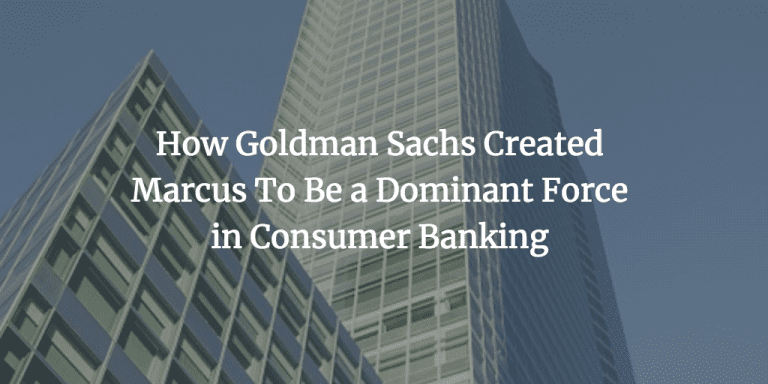[Editor’s note: This article was written for our Chinese audience and will be translated into Mandarin and released with several other articles at the Lendit Fintech China conference in Shanghai in September.]
It all began at the home of a senior Goldman Sachs executive in the summer of 2014. A select group of leaders were there to discuss new growth opportunities for the firm. They wanted to start a new line of business where there was a large unmet customer need and where Goldman Sachs could leverage its resources to gain a competitive advantage in the market.
After 145 years serving only the very wealthiest of clients it was decided that they would launch a consumer bank. In reality, they already had a banking license because during the financial crisis they opted to become a bank holding company. But for years they had never really used this to launch any new products. That changed in 2016.
First, there was the launch of GS Bank in April 2016. Six months later Goldman Sachs introduced the world to their Marcus brand. They began as an online lending platform offering unsecured consumer loans up to $30,000 with interest rates ranging from 5.99% to 22.99% (they now offer loans up to $40,000 and rates range from 6.99% to 24.99% as of August 2018). Their big differentiator was offering no fees. There was no origination fee for the borrower, no prepayment fees and no late fees.
They gained traction very quickly. They crossed $1 billion in total originations within eight month of launch. At the end of their first year they were at $1.7 billion. At that time they brought their deposit business under the Marcus brand, it was formerly branded under GS Bank. Now when you go to the Marcus website you are presented with two options: personal loans and savings accounts (which includes certificates of deposits).
We learned in Goldman Sachs Q2 earnings call in July that Marcus had originated more than $4 billon in total loans since launch and they had 1.5 million customers. Their deposit base is now $23 billion.
Goldman Sachs has made some strategic acquisitions for the Marcus brand as they have grown their business. Last year they acquired the talent from small business lender Bond Street. In January of this year they also acquired the team from credit card startup Final. Then in April they acquired personal finance app Clarity Money, founded by Adam Dell, the brother of billionaire Michael Dell (of Dell Computer fame). I am sure they won’t stop there, more acquisitions will likely continue to be part of the Marcus game plan.
We also heard from David Solomon, who will be taking over as CEO of Goldman Sachs on October 1, at an AllianceBernstein conference a couple of months ago. At this event Solomon laid out the vision for the future of Marcus in a slide that shared 12 business areas the company was either active in or considering. Four areas already offered by Goldman Sachs, under either the Marcus or Goldman Sachs brand are personal loans, savings, wealth management and retirement. Other areas mentioned where we could see Marcus in the future are credit cards, mortgages, auto loans, payments, checking accounts, life insurance and health insurance.
Goldman Sachs is playing the long game here. According to an article in the Wall Street Journal earlier this year the consumer banking business of Goldman Sachs (meaning Marcus) is expected to generate $1 billion in revenue for the firm by 2020. They are not just wanting to be an online lender they are looking to become a diversified financial services firm, one that operates online and direct to the consumer.
The Impact of Marcus
The success of Marcus has certainly not gone unnoticed throughout the banking world. It is almost a daily occurrence now that we hear of a new online or mobile initiative from a major bank. Some recent high profile examples of this in the US are Finn by Chase and Citi’s new national digital bank.
It is interesting that Marcus has all of the advantages of an incumbent bank but few of the disadvantages. It has a deep-pocketed parent company that is committed to its success and willing to give it the resources it needs to succeed. But being a completely new initiative it has no legacy technology, legacy staff or legacy thinking inside the organization. Goldman Sachs is very aware of letting Marcus develop its own culture without any outside influence.
Banks large and small know they have to move from thinking about their digital future to acting on it. The risk of doing nothing is now much larger than the risk of trying something new. Because of their rapid success Marcus has altered the playing field for banks.
It is an exciting time to be in consumer finance. I expect more change to happen in the next five years than in the last 20. The future is obviously going to be digital and the banks that will be the big players in the 21st century are those that embrace their digital future. I will be very surprised if Marcus is not a major player in consumer finance within the next five years.


